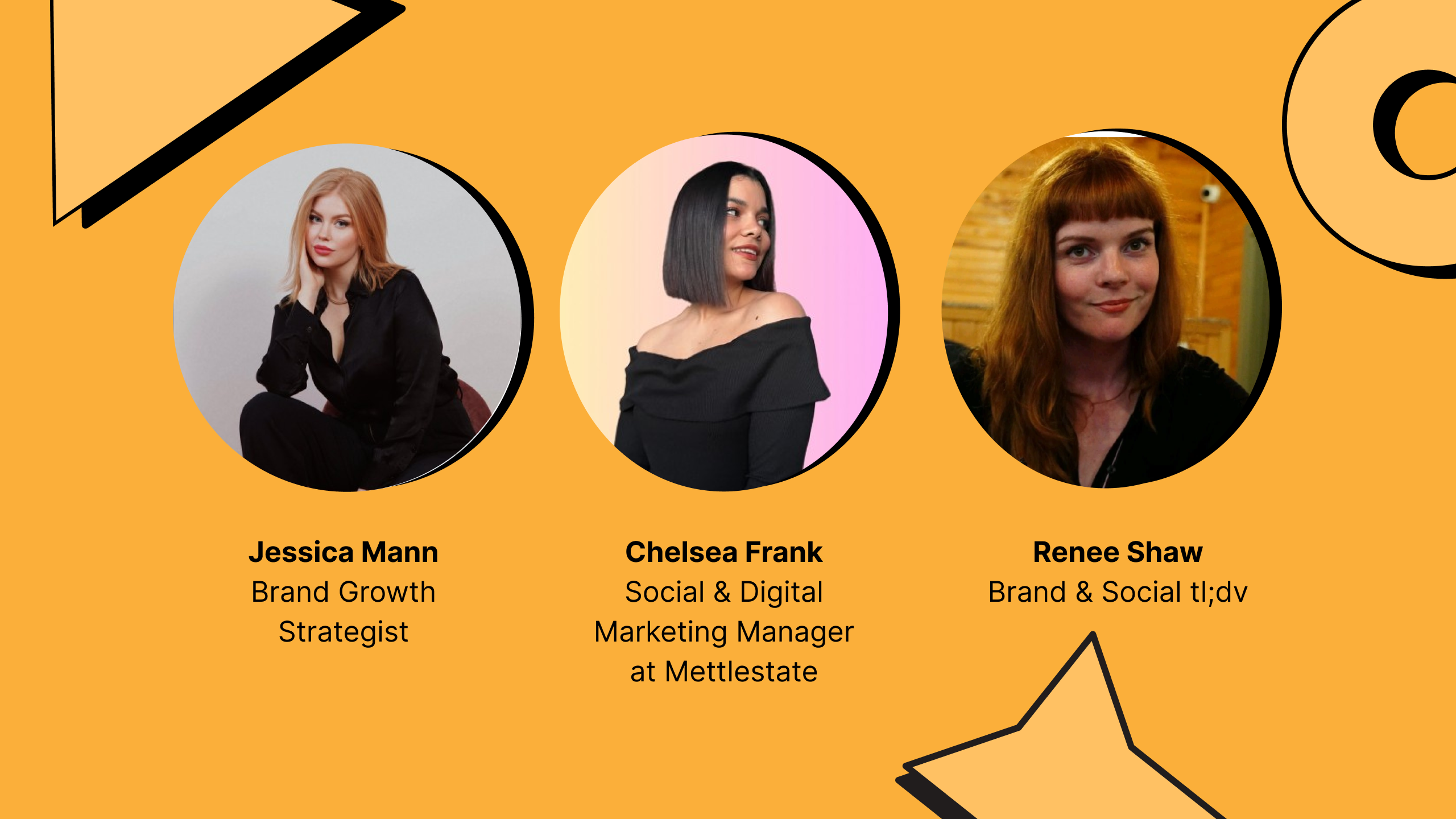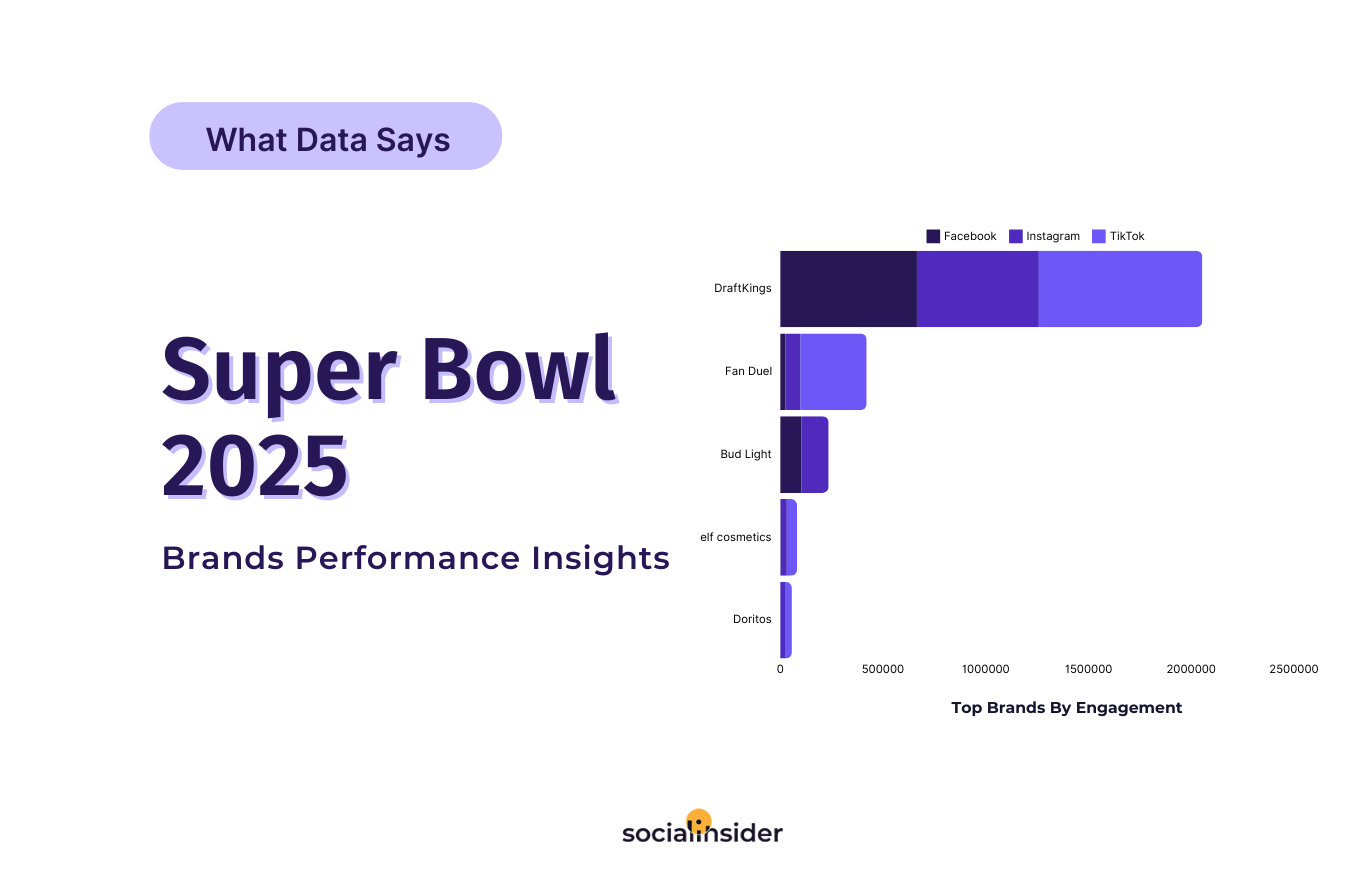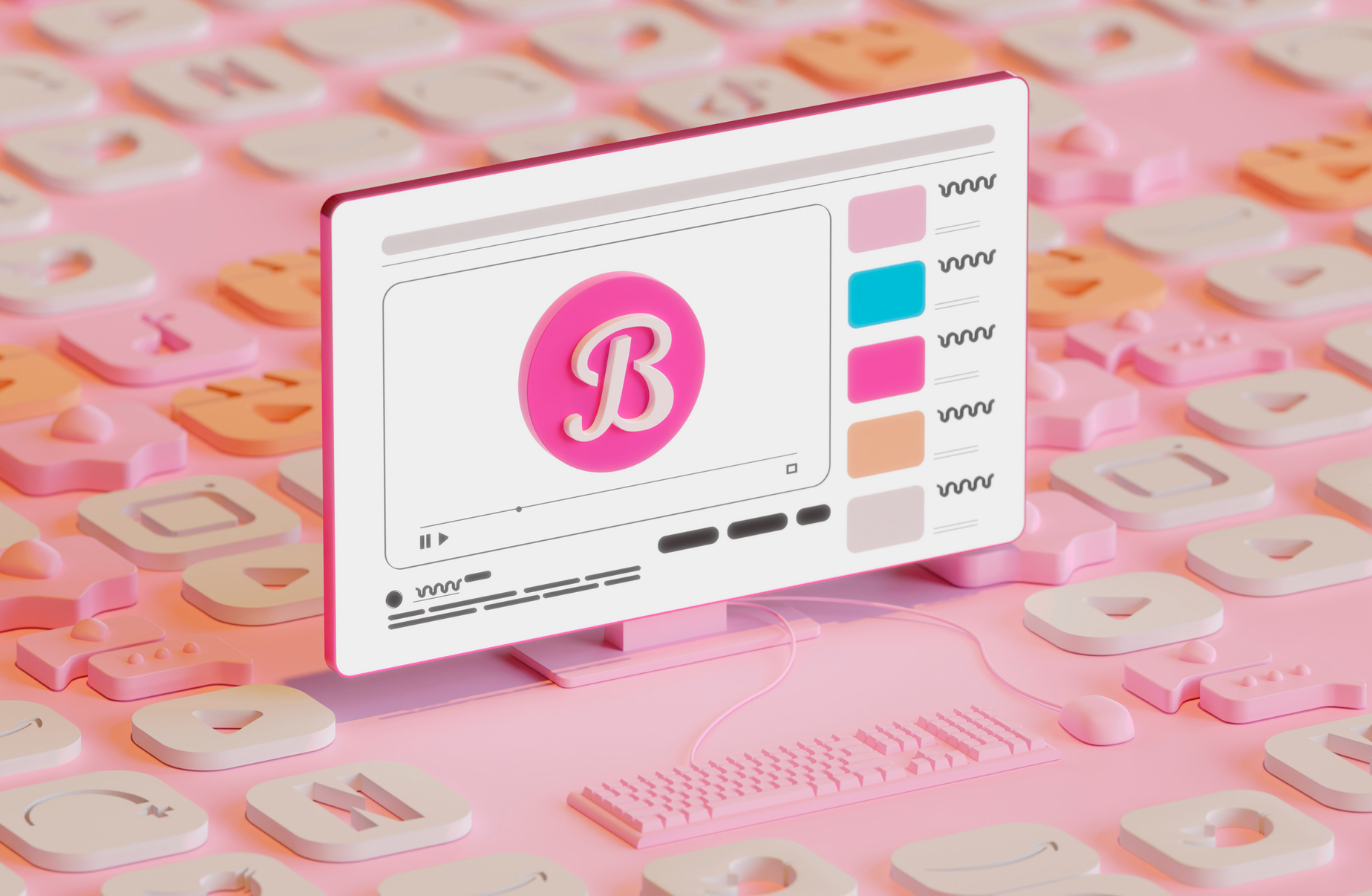Building Brand Awareness: Essential Tips and Strategies for 2025
Building brand awareness is the practice of making your brand known to your audience. Discover below the top strategies on how to build it!

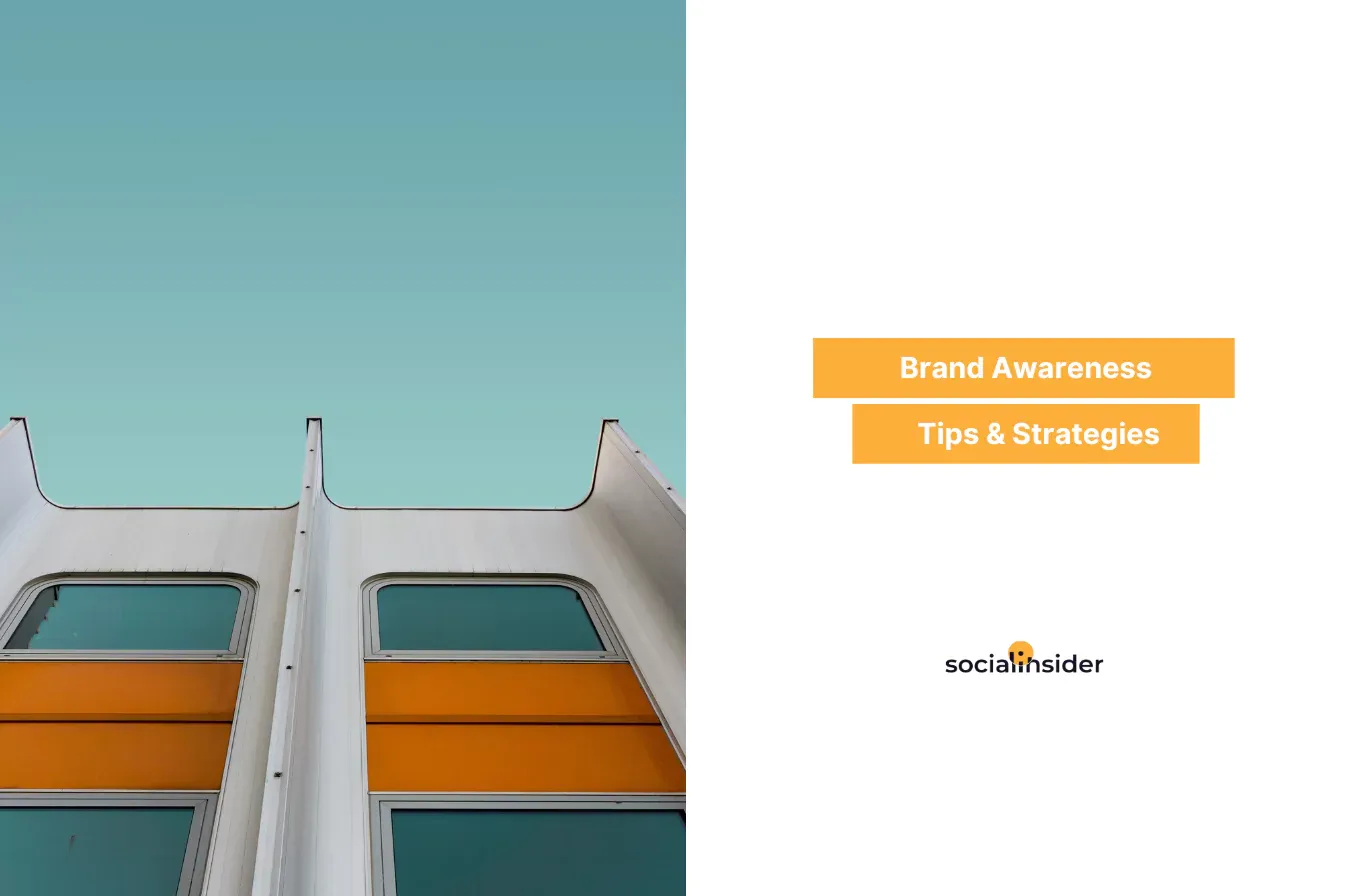
"Space is big. Really big," to quote a famous sci-fi novel, and so is the consumers' universe.
With so many businesses competing for attention, getting traction for yours may seem like rocket science. What if the science is at your fingertips, and all you need is the creative fuel to bring your brand awareness strategy to life?
In this article, you will discover how to get more brand awareness by using the power of data and analytics, leveraging competitor insights, and uncovering relevant social media benchmarks.
What is brand awareness?
Brand awareness refers to the extent to which your target audience recognizes your brand. It measures how familiar consumers are with a brand’s name, logo, and other distinctive elements and how easily they recall its products or services. Building brand awareness is crucial as it lays the foundation for marketing and promotional activities.
Why is brand awareness important?
The founders of Apple used to hang in Steve Jobs’ garage. While they did no manufacturing there, it was the birthplace of the famous brand.
Imagine Jobs and Wozniak had never taken their ideas out of that garage.
Would Apple still be the giant it is today?
Brand awareness means popularizing your products and services through word of mouth, social media platforms, events, or other communication channels. Without awareness, no business can thrive. No one will know or buy the products, no matter how great or valuable.
In short, brand awareness has three essential benefits:
- Consideration. Your brand is on people's minds when making purchasing decisions.
- Trust. Familiarity leads to trust and an increase in buying intent. 80% of consumers consider trust a deciding factor in their buying decisions, according to HBR.
- Loyalty. Clients are likelier to buy repeatedly from a brand they recognize and trust.
How do you position yourself as a trusted brand that people keep returning to?
Follow the tips and strategies below.
5 tips for a successful brand awareness strategy
Building awareness is the first step in the buyer’s journey, so you can’t skip it. Let’s look at some brand awareness tips and best practices to help you get started or refine your existing strategy.
1. Be clear about who you are (or others will)
You’re eager to set up those social media campaigns and start selling. But first, shape how you want your brand to be perceived by the public.
Brand awareness starts with a well-defined brand that includes a name, a logo, a positioning statement, and guidelines that anyone on the team can access.
Work with a designer, copywriter, and other branding experts to develop the visual and text elements that will make you stand out. Aim for branding that is clear, concise, and appealing.
Remember that, at the end of the day…
"Your brand isn’t what you say it is. It’s what they say it is." — Marty Neumeier
2. Be consistent
Consistency helps you build not only a strong brand but also a profitable one. Brand consistency has contributed to a 10 to 20% growth in revenue for businesses included in a 2021 Marq study.
Ensure you use your branding elements on all communication channels and that everyone involved in communication, including agencies and collaborators, is aware of the branding guidelines.
A customer should have the same visual experience and get the same type of message, whether following you on social media, subscribing to the newsletter, or attending an in-store event.
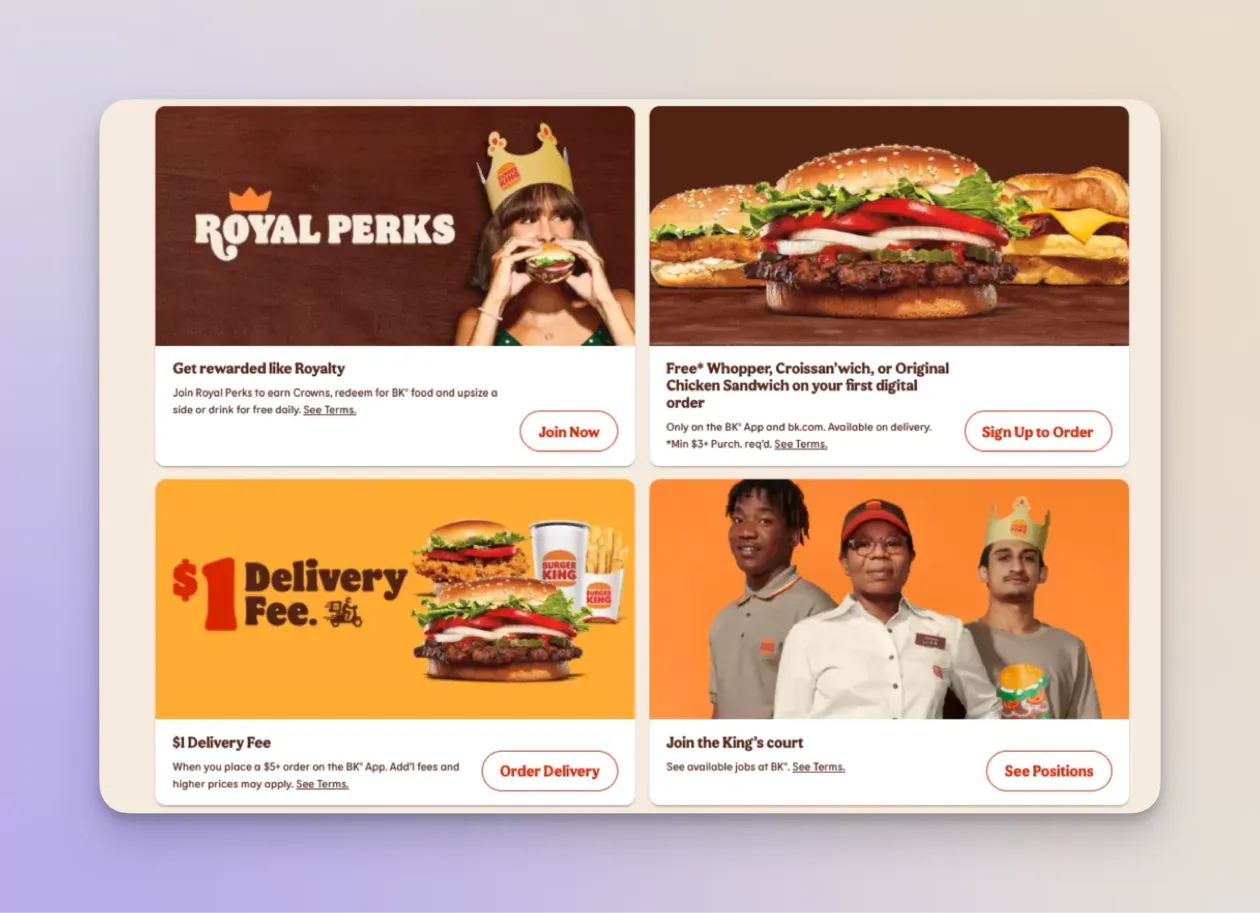
3. Be memorable
Boost brand awareness by standing out from the crowd. Don’t just do what all your competitors are doing, as people will hardly pay any attention to more of the same thing.
Here are ways to be memorable for your audience:
- Use storytelling. Your brand has unique stories. How and why was it born? Who are the people on the team? What’s the story behind the products?
- Create striking visuals, especially for social media brand awareness. Numbers, people’s faces, or relevant product images will always stand out in a busy feed.
- Have an authentic tone of voice that stems from your values and organizational culture.
Remember Barbie’s marketing campaign in 2023? Everyone does because it used all the elements above.

4. Understand the different levels of brand awareness
Increasing brand awareness is a gradual process. It’s helpful to know the different levels of awareness to calibrate your expectations:
- Unawareness. People have not come across your brand, or they have, but they have no recollection of it.
- Awareness. Customers have become aware of your brand through social media campaigns, advertising, word of mouth, or other marketing efforts.
- Recognition. Your target audience is familiar with the brand and can identify it when seeing the name, logo, or other visual elements.
- Recall. Clients remember the brand without visual cues and have a deeper recollection of its products, messaging, and campaigns. If you hear the tagline “Just do it,” what comes to mind?
- Top-of-mind awareness. Congrats! At this level, customers think of your brand first in your product or service category.
Going from one level to the next takes time and requires specific strategies.
Also, different people in your audience will be at various levels, so customize brand awareness strategies for different audience segments.
5. Leverage the power of social media brand awareness
Remember when building brand awareness meant printing brochures, knocking on doors, and talking to (many, many) people personally?
If you don’t, imagine the type of budget, human resources, and time all that entailed.
I’m not saying to stop printing brochures (well, maybe I am). Today, social media and brand awareness go hand in hand.
After all, social media is the top product discovery channel for Gen Z and Millennials, according to Hubspot's State of Marketing Report 2024.
Social media platforms give marketing managers access to all demographics and provide them with various tools to quickly reach clients at a fraction of the cost of traditional brand building. However, it comes with a different type of complexity.
5 strategies to build brand awareness in social media
Social media might seem easy to some. Anyone can post fun stuff on Facebook and Instagram, right? Social media professionals, I see your eyes rolling at this.
Building a strong brand on social media involves planning, production, management, and data analysis—and many decisions:
- Where do you start, and how do you scale?
- How do you choose between competing platforms and tactics?
- How do you efficiently allocate resources?
Don’t panic. Here are 42—just kidding— five essential strategies to guide your brand-building process in the social media space.
1. Get competitive intelligence social media data
With so many platforms available, creating a brand-building strategy without data is like shooting darts in the dark.
Social media data is essential to understanding customers, creating efficient content plans, building strategic partnerships, and staying on top of trends. Access to data brings clarity and helps you choose between a world of possible tactics.
Here’s how to avoid a lot of trial and error when building a brand presence on social media:
- Understand that you’re not starting from zero. Your brand may be new, but the wheel has already been invented and is spinning successfully for others. Analyze and learn.
- Make a list of competitors and influencers in your industry. Add their pages to a social media analytics tool like Socialinsider to quickly analyze and compare key metrics.
- Identify themes and content pillars. Pick top-performing topics for each platform to include in your strategy.
- Monitor relevant hashtags and keywords on an ongoing basis. Assess successful campaigns around them and create even better ones.
Competitor analysis is not about copying strategies. It's about understanding what works and what doesn't, refining your content plan, and backing up authentic stories with the power of data.
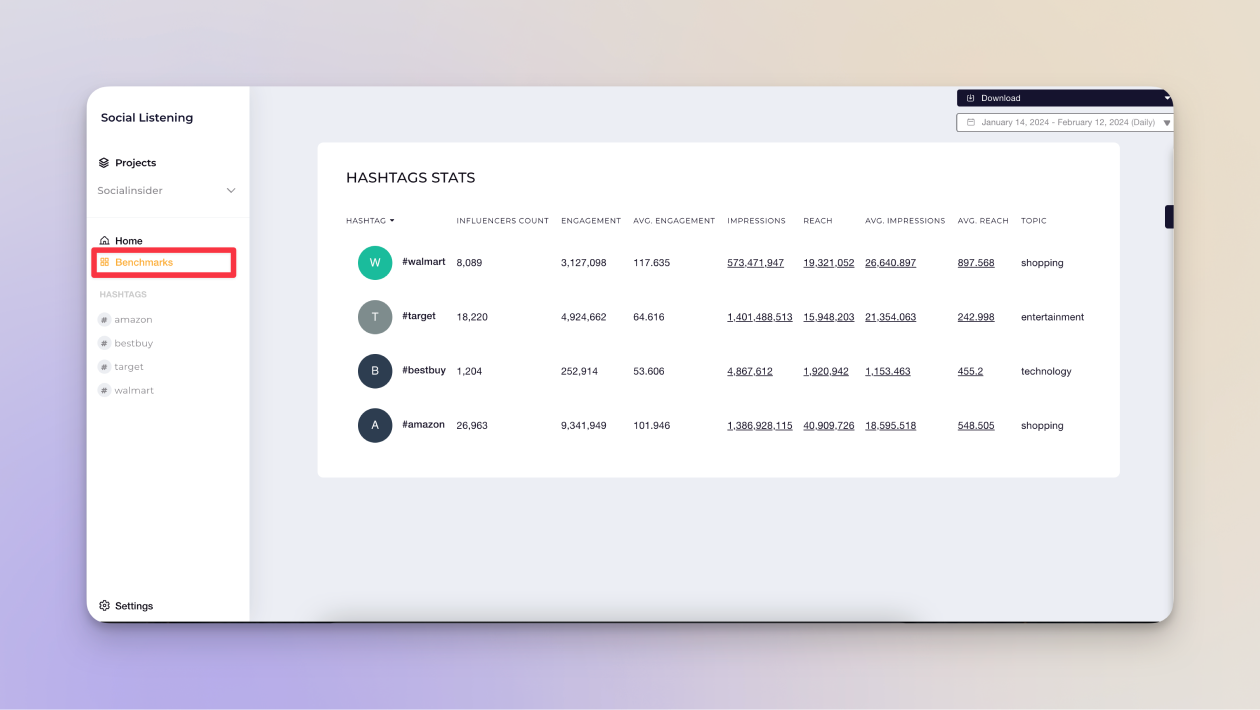
2. Boost organic brand awareness through conversations
People expect more and more from brands. It’s not enough to invest in flashy advertising campaigns. Businesses must be relatable and approachable. Their presence on social media should blend in with that of friends and colleagues and not look like a sales pitch.
Strive to create content that sparks conversation to be relatable and get organic brand awareness. Here are a few ideas:
- Use anecdotes about your brand, team, and products.
- Host live sessions with company experts.
- Feature user-generated content to show the audience you value participation.
- Reply to comments and messages to encourage interaction.
- Ask fun, intriguing, or thought-provoking questions.
- Post polls to encourage followers to share their opinions.
Organic brand awareness is the first step toward building a strong, engaged community around your business.

3. Leverage popular keywords, hashtags, and content themes
Strong brand awareness comes not only from generating conversations but also from joining existing ones. This approach helps you get more visibility, participate in trends, and broaden your audience.
Identify and monitor relevant content themes for your industry or niche. Look for opportunities to participate in conversations by directly engaging with other people’s content through likes, shares, and comments. Integrate hashtags and keywords in your content without overdoing it.
Socialinsider’s Strategy feature helps you tag and group social media postings based on keywords or hashtags.
Let’s say you want to see how content around the keyword “World economic forum” is performing. You can pick a popular news outlet such as Morning Brew and get detailed information about posts and engagement and understand what gets people talking.
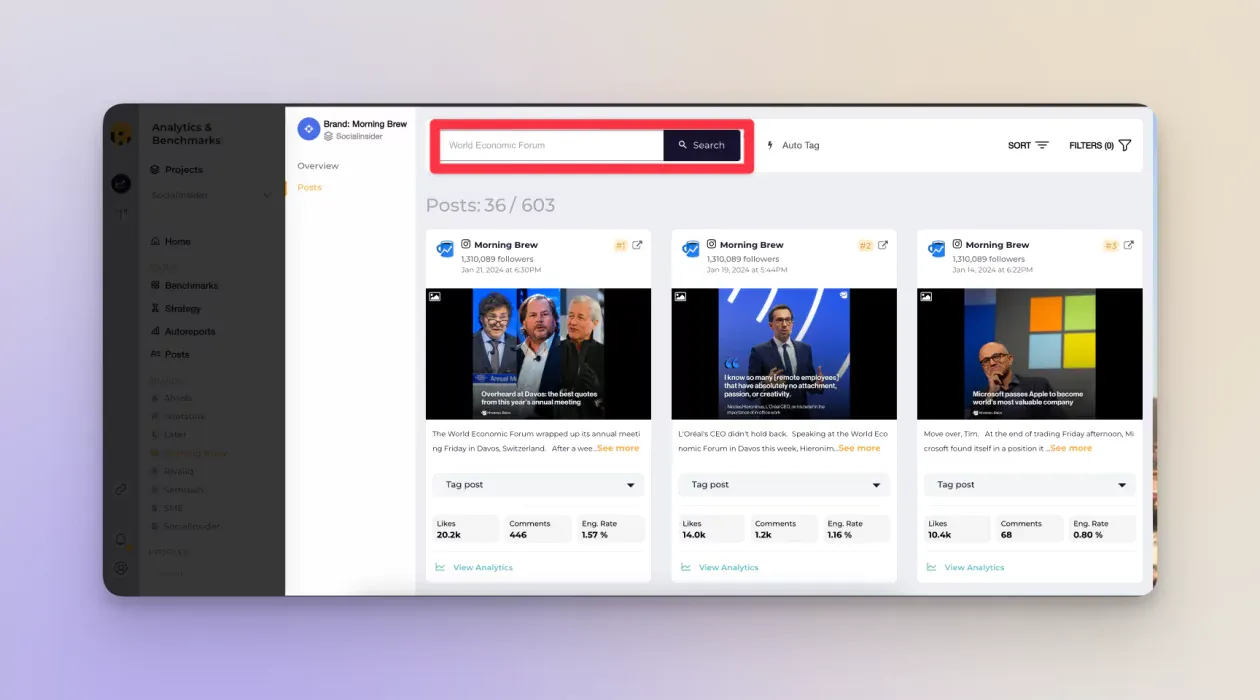
4. Create strategic influencer marketing partnerships
Influencer marketing has been on the rise for a few years now. Most digital marketing strategies include an influencer component, but not all collaborations are equal.
Instead of chasing large communities, focus on smaller, more niche influencers. Micro-influencers drive the most brand awareness, giving businesses access to loyal communities at a lower cost, Hubspot's 2024 report cited above has found.
Let’s say you are an online retailer selling sports equipment, and you’re looking to boost brand awareness on Instagram by joining trending topics relevant to your audience. For example, you could use Socialinsider’s social media listening feature to find all influencers who use #superbowl.
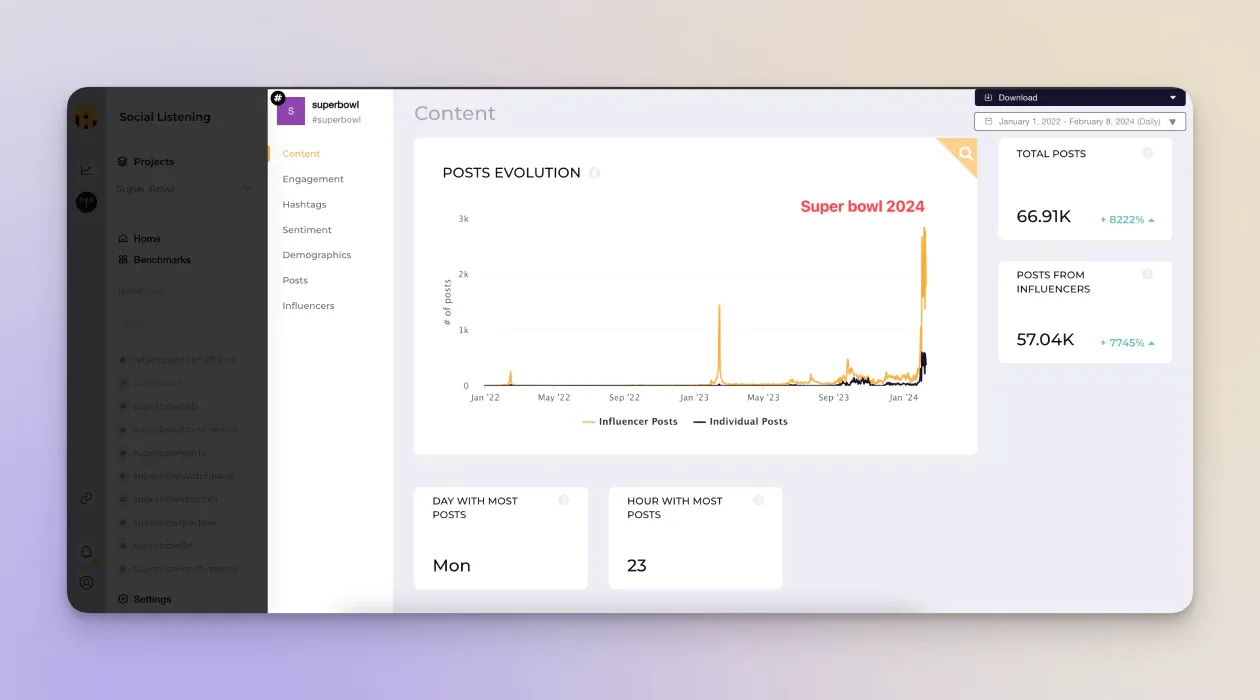
To identify partnership opportunities, filter the results by the number of followers, language, or topics discussed. You can generate a short list of relevant influencers that fit your brand and strategy in just a few minutes.
5. Create data-powered brand awareness campaigns
Given the low organic traffic social media platforms generate, paid campaigns are an important part of building brand awareness. To spend your marketing budget wisely, create campaigns based on audience and industry analytics.
- Gather data on your audience's demographics, interests, and preferences. Platforms allow for detailed campaign targeting, so having a well-defined audience helps you get your brand message in front of the right people.
- Analyze competitors’ social media content pillars to understand their strategy, top-performing content, and engagement tactics.
- Check the latest benchmarks for Instagram, LinkedIn and other platform.
- Create content that is tailored for every social media platform. For example, an ad that might perform well on YouTube might be ignored by the audience on TikTok.
- Use trending and relevant hashtags to increase the discoverability of your content.
- Set clear, measurable objectives to monitor results, understand performance, and optimize.
How to measure brand awareness on social media
Building brand awareness is not an exact science, and sometimes results are hard to grasp. However, social media analytics reduce uncertainty and empower brands to understand the effectiveness of their efforts in real-time.
Basically, measuring brand awareness on social media comes down to consistently monitoring key top-of-funnel metrics.
Social media reach
Reach in social media means how many people your content has, well, reached. This metric measures if a brand’s post has appeared in my Facebook feed, for example, but it doesn’t also imply that I paid attention to it.
When tracked over time, reach can reveal if your marketing efforts are working to bring the brand in front of more people, whether through organic posts or paid campaigns.
Impressions for social media content
Impressions measure how many times a piece of content has appeared in people’s feeds.
For instance, if a social media post generates a lot of shares, the same person might view it several times, increasing the number of impressions. People generally need to see the same message or visual a few times before remembering it, so getting more impressions is a great way to improve brand recognition.
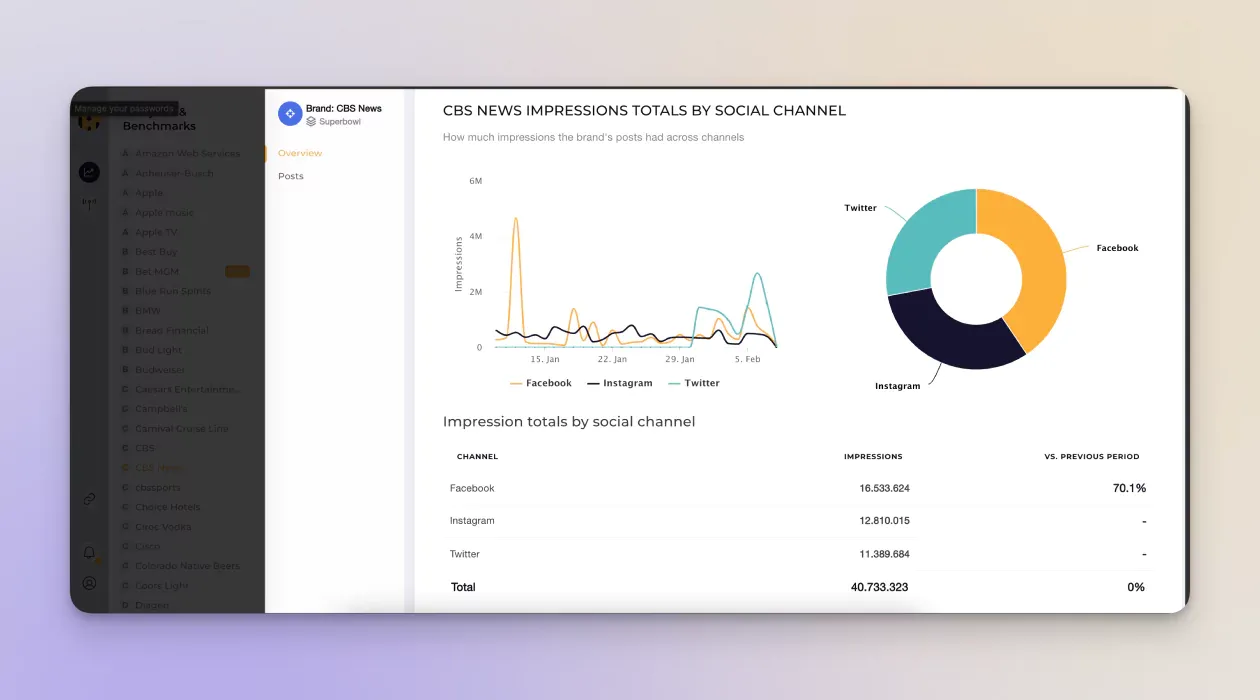
Brand audience growth rate
The follower count used to be an important metric for brands, and then, with the drop in organic reach, it became more of a vanity metric. However, tracking the rate at which your social media audience grows indicates how well your content is doing.
Low growth rates indicate problems in targeting, messaging, content quality, or even choice of platform. Combined with other metrics, it can help you identify gaps or opportunities in your strategy.
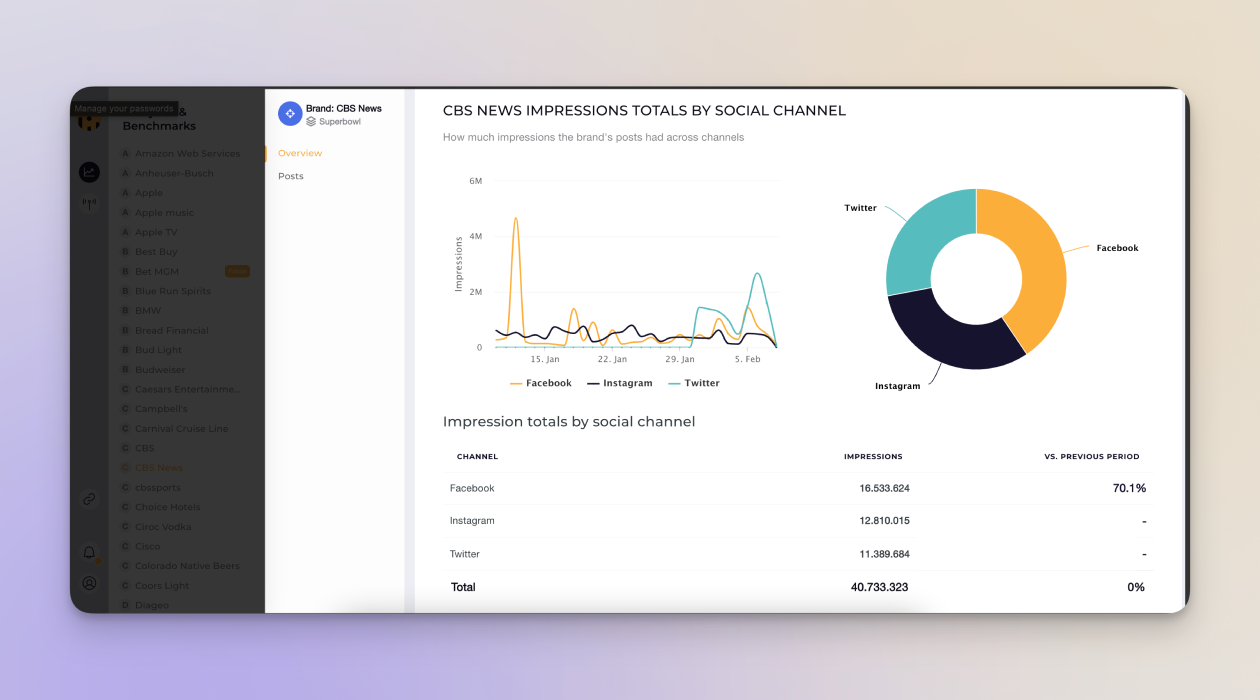
Social share of voice
Let’s say you have been building your brand for a while, and your audience numbers are increasing. But are you on people’s minds?
While no social media listening tool is a mind reader, social share of voice is a powerful metric that calculates how much people are talking about your brand on social media compared to competitors.
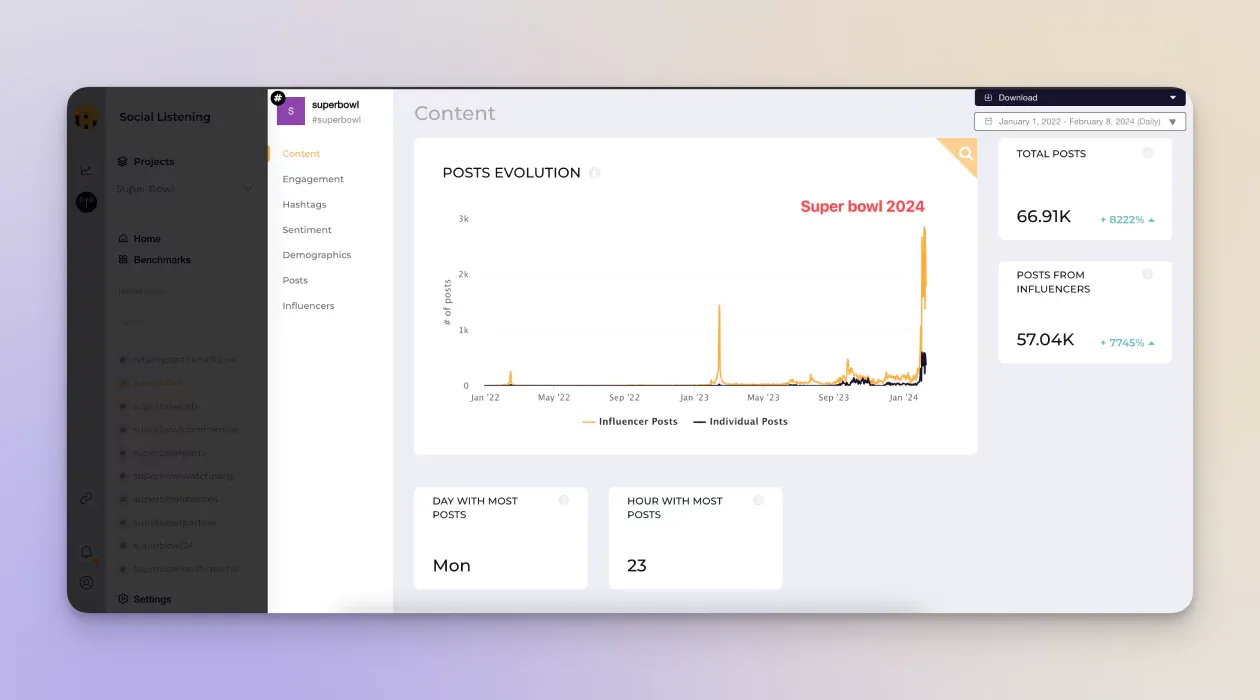
Metrics at a glance
By looking at the metrics above combined over weeks, months, or years, you can clearly see how well your brand is doing.
Here’s an example of Socialinsider’s cross-channel analytics dashboard that shows all important brand awareness metrics across platforms at a glance.
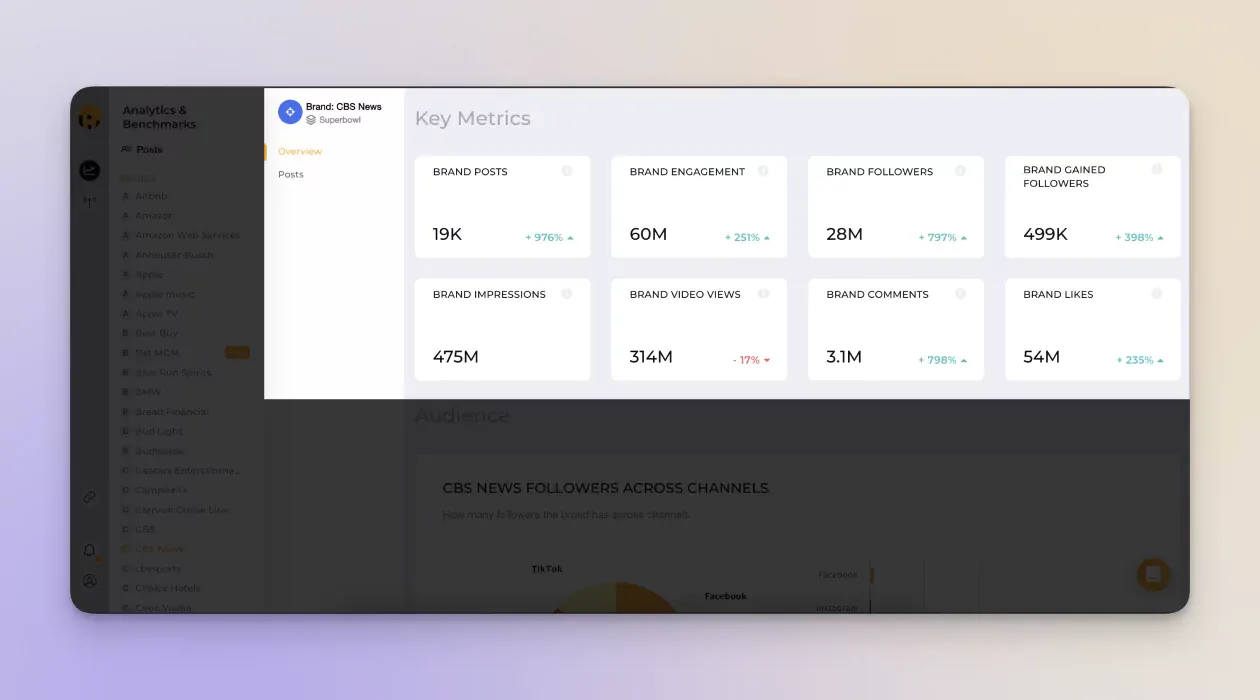
Get a more granular view by looking at the metrics broken down by platform.
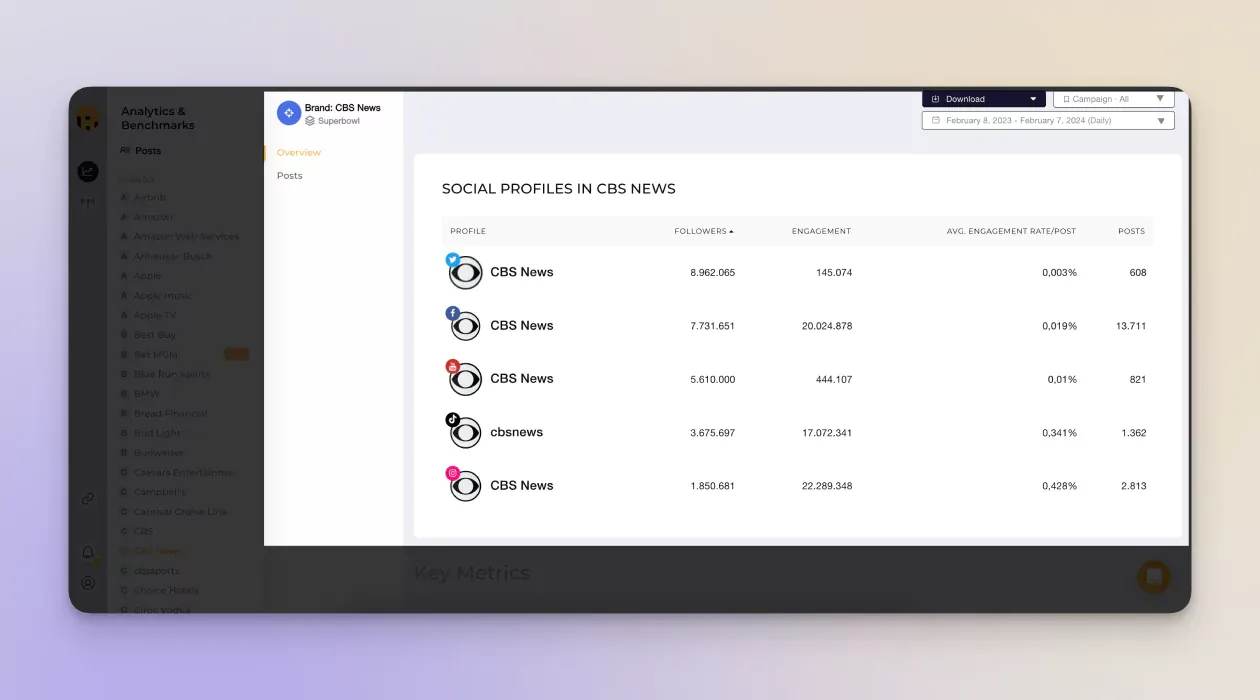
Analyze each metric to see its evolution across channels and better understand where your brand is performing well and where there is room for improvement.
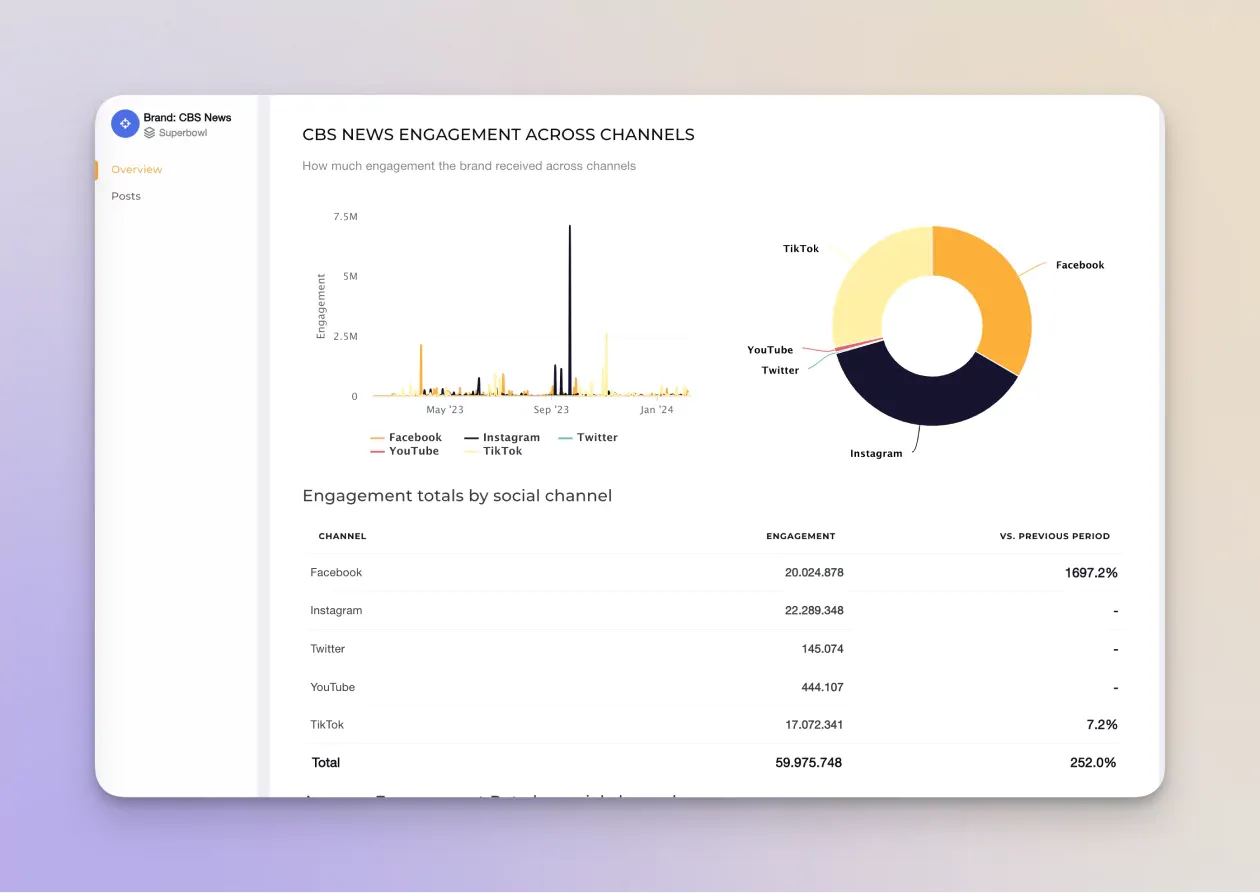
Switch between a bird’s eye view of performance to an in-depth analysis of platforms and metrics, depending on your needs.
Remember not to get lost in the numbers but to use them strategically to fuel creative efforts and be successful at building brand awareness in a vast, ever-expanding galaxy of competitors.
Final thoughts
Building strong brand awareness is an ongoing process that requires consistency. Strive to create quality content that makes your brand memorable and shareworthy, whether online or offline. And don’t go at it alone.
Leverage Socialinsider to create a strong social media brand awareness strategy based on data and research into competitors, influencers, and content themes. Your target audience is already there, paying attention. Be present and relevant.
Analyze your competitors in seconds
Track & analyze your competitors and get top social media metrics and more!
You might also like
Improve your social media strategy with Socialinsider!
Use in-depth data to measure your social accounts’ performance, analyze competitors, and gain insights to improve your strategy.

